| |
|
Xiamen Oil Paintings, Wholesale Direct!
|
|
100% hand painted, 100% cotton canvas, 100% money back if not satisfaction. |
|
|
|
|
ART WORKS INDEX
A
B
C
D
E
F
G
H
I
J
K
L
M
N
O
P
Q
R
S
T
U
V
W
X
Y
Z
|
|
ARTISTS INDEX
A
B
C
D
E
F
G
H
I
J
K
L
M
N
O
P
Q
R
S
T
U
V
W
X
Y
Z
|
|
|
|
|
|
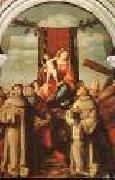 |
LICINIO, Bernardino
|
|
Italian painter, Venetian school (b. ca. 1489, Poscante, d. ca. 1565, Venezia)
|
|
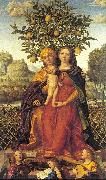 |
Libri, Girolamo dai
|
|
Italian Painter, ca.1474-1555
Illuminator and painter, son of Francesco dai Libri. He was evidently trained by his father, but he received commissions for altarpieces as well as manuscripts. Documents indicate that he lived in Verona all his life, but an early miniature of the Nativity, the only work by him in a series of choir-books almost certainly painted in Ferrara, suggests that he may have spent some time there. Vasari's record that he worked as an illuminator in the monastery of S Salvatore in Candiana (Padua) may be true, as some of Girolamo's surviving miniatures were executed for the abbey. The only record of Girolamo's views on his art occurs in a register of 1544: 'a good and worthy painter must know how to imitate nature well and to feign that which nature makes, and he must be universal in depicting landscapes
|
|
|
|
|
|
 |
lhote
|
|
Andre Lhote (5 July 1885 -- 25 January 1962) was a French sculptor and painter of figure subjects, portraits, landscapes and still life. He was also very active and influential as a teacher and writer on art.
Lhote was born in Bordeaux and learnt wood carving and sculpture from the age of 12, when his father apprenticed him to a local furniture maker to be trained as a sculptor in wood. He enrolled at the École des Beaux-Arts in Bordeaux in 1898 and studied decorative sculpture until 1904. Whilst there, he began to paint in his spare time and he left home in 1905, moving into his own studio to devote himself to painting. He was influenced by Gauguin and C??zanne and held his first one-man exhibition at the Galerie Druet in 1910, four years after he had moved to Paris.
After initially working in a Fauvist style, Lhote shifted towards Cubism and joined the Section d'Or group in 1912, exhibiting at the Salon de la Section d'Or. He was alongside some of the fathers of modern art, including Gleizes, Villon, Duchamp, Metzinger, Picabia and La Fresnaye.
The outbreak of the First World War interrupted his work and, after discharge from the army in 1917, he became one of the group of Cubists supported by Leonce Rosenberg. In 1918, he co-founded Nouvelle Revue Française, the art journal to which he contributed articles on art theory until 1940. Lhote taught at the Academie Notre-Dame des Champs from 1918 to 1920 and later taught at other Paris art schools including his own school, which he founded in Montparnasse in 1922.
Lhote lectured extensively in France and abroad, including Belgium, England, Italy and, from the 1950s, also in Egypt and Brazil. His work was awarded with the Grand Prix National de Peinture in 1955, and the UNESCO commission for sculpture appointed Lhote president of the International Association of Painters, Engravers and Sculptors. Lhote died in Paris in 1962.
|
|
 |
Lhermitte, Leon
|
|
French Realist Painter, 1844-1925
was a French painter and etcher of the late nineteenth century. A student of Lecocq de Boisbourdran, he was a realist artist whose primary subject matter was of rural scenes depicting the peasant worker. He gained recognition after his show in the Paris Salon in 1864. His many awards include the French Legion of Honour (1884) and the Grand Prize at the Exposition Universelle in 1889. Lhermitte's innovative use of the then contemporary media of pastels won him the admiration of his contemporaries. Vincent Van Gogh wrote that If every month Le Monde Illustr published one of his compositions... it would be a great pleasure for me to be able to follow it. It is certain that for years I have not seen anything as beautiful as this scene by Lhermitte
|
|
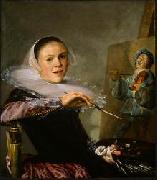 |
LEYSTER, Judith
|
|
Dutch Baroque Era Painter, 1609-1660
Dutch painter. A brewer's daughter, she had gained membership in the Haarlem painters' guild by age 24. Many of her known works, primarily portraits, genre paintings, and still lifes, were formerly attributed to her male contemporaries. Though the influence of Frans Hals is clear, she was also interested in the Baroque style of the Utrecht school. She embraced a greater range of subjects than other Dutch painters of the era
|
|
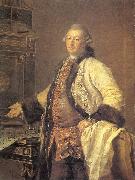 |
Levitsky, Dmitry
|
|
Russian Painter, 1735-1822
.Russian painter of Ukrainian birth. Together with Fyodor Rokotov and Vladimir Borovikovsky, he ranks foremost among 18th-century Russian portrait painters. He received his first lessons in painting from his father, Grigory Levitsky-Nos (1697-1769), a priest, engraver and painter. He also studied under Aleksey Antropov, who had come to Kiev to decorate St Andrew's church (1752-5). In the late 1750s Levitsky went with Antropov to St Petersburg, where he stayed until 1764; he continued with lessons from Antropov to whom, it appears, he owed the objectivity that was to characterize his work. It is probable that he also studied at the St Petersburg Academy of Arts, attending classes under Louis Lagren?e. Levitsky worked with Antropov on the decoration of triumphal arches in Moscow for Catherine II's coronation in 1762. His first known portraits are rather formal, for example that of the architect Aleksandr Kokorinov (1769; St Petersburg, Rus. Mus.), which won Levitsky the title of Academician in 1770. In such works he made successful use of a compositional structure typical of formal European portrait painting, intended to emphasize the importance of the sitter.
|
|
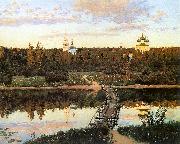 |
Levitan, Isaak
|
|
Russian Painter, 1860-1900
Russian painter of Lithuanian birth. He largely painted landscapes (including pastel sketches), which are noted for their emotive or symbolic resonance. His 'landscapes of mood' had a profound influence on Russian landscape painting, to which he introduced a sense of the unity of humankind and nature, and of the spiritual power of the Russian
|
|
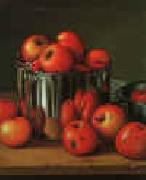 |
Levi Wells Prentice
|
|
1850-1935
Levi Wells Prentice Gallery
Prentice was associated with the Hudson River School, a group of artists known throughout art circles. According to the book Nature Staged by Barbara Jones, Prentice followed a self-prescribed educational path, begun by the Hudson River School and reinforced by John Ruskin's (1819-1900) truth-to-nature principles laid out in his book Modern Painters. Although he can be allied to both schools of thought, Prentice can not be considered a member of either. This book has a photo of the artist in his early Brooklyn studio surrounded by his paintings and a complete essay on his life and work.
Levi grew up on a farm in Lewis County, New York. By 1872, Prentice had traveled through the Adirondack Mountains, painting the views as well as the surrounding region. He opened his first studio as a landscape painter in Syracuse, New York in 1875.
Self-taught artist Levi Wells Prentice is best known for his realistic still life compositions of fruit arranged within a landscape, or abundantly spilling from bushel baskets. Early in his career, he painted portraits and landscapes of the Adirondack Mountain region of Lewis County, New York, his birthplace.
Levi married an English woman Emma Roseloe Sparks in Buffalo, New York in 1882 and had two children, Leigh (born 22 March 1887) and Imogene (born 17 September 1889).
Prentice then turned to painting still life subjects when he moved briefly to Brooklyn, New York in 1883, focusing on fruit, in order of frequency apples, strawberries, peaches, plums, raspberries, cherries, muskmelons, pears, currants, pineapples, gooseberries, grapes and bananas usually piled high in pots or in natural settings.
Prentice subsequently moved around from 1903-07 before settling in the Germantown district of Philadelphia. However, his work did not gain much recognition with historians until the 1970s. He was a member of the Brooklyn Art Association and frequently exhibited his paintings there.
In addition to his artistic talents, he was a craftsman who enjoyed making his own brushes, palettes and frames.
In his painting, Prentice placed an emphasis on dark outlining with a concern for textual precision, creating dramatic contrasts. The shift between dark background areas and the vibrant hues of the fruit are done to give the compositions an exciting, visual energy. The fruit is presented with clarity and precision. An emphasis appears to be placed on the idea of man versus nature. The wooden baskets with hand-wrought nails represent a structured, man-made object, while the overly ripe fruit represents the fleeting qualities of nature. These paintings also demonstrate Prentice's remarkable skills at rendering color, form, and texture.
Noted art historian William H. Gerdts observed: there are several works by Prentice in which he achieves a quality of illusionism which is unsurpassed. In 1993, the skillful 'illusionism' of Levi Wells Prentice was celebrated in a retrospective exhibition at the Adirondack Museum in New York. His works continue to receive a high degree of appreciation by collectors today. He is represented in many museums including the New York State Museum, Museum of Fine Arts, Boston, Montclair Art Museum, Philbrook Museum of Art and Yale University Art Gallery.
Levi died 28 November 1935 in Germantown, Pennsylvania.
|
|
 |
Lev Kamenev
|
|
Russian, 1833-1886
Russian political leader. A member of the Bolsheviks from 1903, he worked with Vladimir Ilich Lenin in Europe (1909 ?C 14), then returned to Russia, where he was arrested and sent to Siberia. After the Russian Revolution of 1917, he served as head of the Moscow soviet (1919 ?C 25). When Lenin became seriously ill in 1922, Kamenev joined Joseph Stalin and Grigory Y. Zinovyev to form the ruling triumvirate, attacking Leon Trotsky. In 1925 Stalin shifted his attack to Kamenev and Zinovyev, removng Kamenev as Moscow party head. In 1926 Kamenev was expelled from the party after conspiring with Zinovyev and Trotsky against Stalin.
|
|
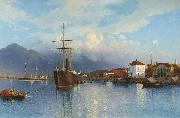 |
Lev Feliksovich Lagorio
|
|
(Russian: 1828-1905) was a Russian painter, known for his paintings of seascapes.
Lagorio was born in Feodosia, Crimea (now Ukraine) and later studied in the Imperial Academy of Arts in Saint Petersburg. His teachers were Maxim Vorobiev and B. P. Villeval'de. While he lived in Feodosia, he was influenced by the painter Ivan Aivazovsky. In 1845 Lagorio went on a sea voyage on the warship Groziashchy to study the arrangement of the ship.
Lagorio spent eight years in Italy. The paintings he created there brought him to the status of professor on his return home to Russia.
In his later years, he painted the coastal views of Finland and Norway. He also painted motives of the Russian-Turkish war.
|
|
|
|
|
|
 |
lesueur
|
|
Charles Alexandre Lesueur (Le Havre, January 1, 1778 - Le Havre, December 12, 1846) was a French naturalist, artist and explorer.
Pictured here is the oil portrait by Charles Willson Peale of Charles-Alexandre Lesueur. The original hangs in the reading room of the of Ewell Sale Stewart Library in the Academy of Natural Sciences of Philadelphia.
In 1801 he traveled to Australia as artist on the expedition of Nicolas Baudin. With François Peron he took over the duties as naturalist after the death of the expedition's zoologist Rene Mauge. Together they collected over 100,000 zoological specimens.
Between 1815 and 1837 he lived in the United States In 1833, he visited Vincennes, Indiana where he sketched the first known drawing of Grouseland, the mansion of William Henry Harrison. The mansion is today a National Historic Landmark.
In the years 1825-1837 Lesueur lived in New Harmony, Indiana, where he filled sketchbooks full of the finds discovered during the utopian adventure funded by his friend William Maclure. He drew the boat "Philanthropist", which arrived full of intellectuals who came to live in the small town of New Harmony, on the Wabash River. He took research trips and sketched the people and the small towns in the area. He was in New Harmony when Prince Maximilian, Prince of Wied-Neuweid, Germany, and artist Karl Bodmer came to spend five months there in 1832-1833. Prince Maximilian said of Bodmer "He had explored the country in many directions, was acquainted with everything remarkable, collected and prepared all interesting objects and had already sent considerable collections to France" (Elliott Johansen, p. 6) Indeed, LeSeur sent specimens of unique fish, animals and fossils, as well as artifacts he had dug from the Indian Mounds in New Harmony back to France, where they remain.
LeSeur returned to France in 1837, only after his friends Thomas Say and Joseph Barabino had died and William MacClure had returned to Philadelphia, accompanied by many of his fine books. He had spent 21 years in the United States, but continued his scholarly studies and activities in France, where he resumed his occupation of artist-naturalist and began to catalogue his extensive research and artwork. At last, he was awarded the honor of Chevalier de l??Ordre Royal de la L??gion d'honneur for his long years of work in the sciences
|
|
 |
Lesser Ury
|
|
1861 - 1931
was a German Impressionist painter and printmaker. He was born Leo Lesser Ury in Birnbaum, the son of a baker whose death in 1872 was followed by the Ury family's move to Berlin. In 1878 Lesser left school to apprentice with a tradesman, and the next year he went to D??sseldorf to study painting at the Kunstakademie. Ury spent time in Brussels, Paris, Stuttgart, and other locations, before returning to Berlin in 1887. His first exhibition was in 1889 and met with a hostile reception, although he was championed by Adolph von Menzel whose influence induced the Academie to award Ury a prize. In 1893 he joined the Munich Secession, one of the several Secessions formed by progressive artists in Germany and Austria in the last years of the 19th century. In 1901 he returned to Berlin, where he exhibited with the Berlin Secession, first in 1915 and notably in 1922, when he had a major exhibition. By this time Ury's critical reputation had grown and his paintings and pastels were in demand. His subjects were landscapes, urban landscapes, and interior scenes, treated in an Impressionistic manner that ranged from the subdued tones of figures in a darkened interior to the effects of streetlights at night to the dazzling light of foliage against the summer sky. Ury is especially noted for his paintings of nocturnal cafe scenes and rainy streets. He developed a habit of repeating these compositions in order to sell them while retaining the originals, and these quickly made and inferior copies have harmed his reputation.
|
|
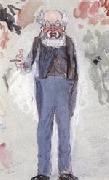 |
Leslie Ward
|
|
British Illustrator caricaturist and portrait painter , (1851-1922),
was a British portrait artist and caricaturist who drew or painted numerous portraits which were regularly published by Vanity Fair, under the pseudonym "Spy". Ward was one of eight children of artists Edward Matthew Ward and Henrietta Ward, and the great-grandson of the artist James Ward. Although they had the same surname before marriage, Ward's parents were not related. Both were well-known history painters, his mother coming from a line of painters and engravers, including her father, the engraver and miniature painter George Raphael Ward, and her grandfather, the celebrated animal painter James Ward. She was niece and great-niece respectively of the portrait painter John Jackson and the painter George Morland. Both parents had studios in their homes in Slough in Buckinghamshire and Kensington in London, where they regularly entertained the London artistic and literary elite. Ward's father was a gifted mimic who entertained Charles Dickens and other eminent guests. Although they never gave their son formal training, they and their artistic friends encouraged the young Ward to draw, paint, and sculpt.[1] Ward had started caricaturing while still at school at Eton in Windsor, using his classmates and school masters as subjects. In 1867 his bust of his brother was exhibited at the Royal Academy in London. At school Ward had been an unexceptional student, and after he left Eton in 1869 his father encouraged him to train as an architect. Ward was too afraid to tell his father that he wanted to be an artist and he spent an unhappy year in the office of the architect Sydney Smirke, who was a family friend.
|
|
|
|
|
|
|
|
|
|
 |
Leopold Robert
|
|
(13 May 1794 - 20 March 1835), Swiss painter, was born at La Chaux-de-Fonds (Neuchâtel) in Switzerland, but left his native place with the engraver Girardet at the age of sixteen for Paris.
He was on the eve of obtaining the grand prix for engraving when the events of 1815 blasted his hopes, for Neuchâtel was restored to Prussia, and Robert was struck off the list of competitors as a foreigner. Whilst continuing his studies under Girardet he had never ceased to frequent the studio of David, and he now determined to become a painter, and only returned to his native country when his master himself was exiled. At Neuchâtel he attracted the notice of Roullet de Mezerac, who enabled him by a timely loan to proceed to Rome. In depicting the customs and life of the people, of southern Italy especially, he showed peculiar feeling for the historical characteristics of their race.
After executing many detached studies of Italian life Robert conceived the idea of painting four great works which should represent at one and the same time the four seasons in Italy and the four leading races of its people. In the "Return from the Fete of the Madonna dell'Arco" (Louvre) he depicted the Neapolitans and the spring. This picture, exhibited at the Salon of 1827, achieved undoubted success and was bought for the Luxembourg by Charles X; but the work which appeared in 1831 the "Summer Reapers arriving in the Pontine Marshes" (Louvre), which became the property of Louis Philippe established the artist's reputation.
Florence and her autumn vineyards should now have furnished him with his third subject. He attempted to begin it, but, unable to conquer his passion for Princess Charlotte Napoleon (then mourning the violent death of her husband, Robert's devoted friend), he threw up his work and went to Venice, where he began and carried through the fourth of the series, the "Fishers of the Adriatic." This work was not equal to the "Reapers." Worn by the vicissitudes of painful feeling, and bitterly discouraged, Robert committed suicide before his easel on 20 March 1835, on the tenth anniversary of the melancholy suicide of a brother to whom he had been much attached.
|
|
|
|
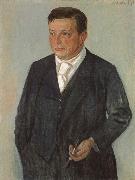 |
Leopold Graf Von Kalckreuth
|
|
1855-1928,German painter and etcher. The son of the late Romantic landscape painter Eduard Stanislaus, Graf von Kalckreuth (1820-94), he studied from 1875 to 1878 under Ferdinand Schauss (1832-1916), Willem Linnig (1819-85) and Alexander Struys (1852-1941) at the Kunstschule in Weimar founded by his father. In 1879, after military service, he enrolled at the Akademie in Munich, where he attended Gyula Benczer's drawing classes and continued his study of painting under Karl Theodor von Piloty and Wilhelm von Diez (1839-1907). In 1883 he travelled to the Netherlands and then to Italy and France. In 1885 he accepted a teaching appointment at the Kunstschule in Weimar, but in 1890 he resigned and returned to Munich. During the next five years he worked at Heckricht in Silesia (now Jedrzychowice, Poland), perfecting his oil technique. In 1892 he was a founder-member of the Munich Secession. Kalckreuth's work from this period reflects the influence of several contemporaries; the portrait of the Artist's Wife of 1888 (Leipzig, Mus. Gesch.) recalls the portraits of Franz von Lenbach and Max Liebermann, while the visionary element brought to the genre scene Rainbow (1894-6; Munich, Neue Pin.) is close to the work of Fritz von Uhde.
|
|
|
|
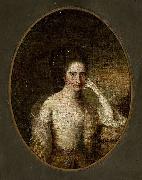 |
Leonor de Almeida Portugal
|
|
Leonor de Almeida Portugal de Lorena e Lencastre (Lisboa, 31 de outubro de 1750 - Benfica, 11 de outubro de 1839) foi uma nobre e poetisa portuguesa.
|
|
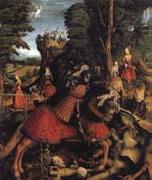 |
Leonhard Beck
|
|
German Northern Renaissance Painter, ca.1480-1542, Illuminator, painter, draughtsman and woodcutter, son of Georg Beck. He first appears as an illuminator and collaborator with his father in two Psalters for the Augsburg monastery of SS Ulrich and Afra in 1495, producing 35 coloured initial letters for each of them (Augsburg, Staats- & Stadtbib., Cod. 49a). These are vigorously coloured but fairly uniform in character, with small, lively biblical scenes excellently adapted to the letters. Red, green and blue predominate; ochre tones provide a link with the gold ground. The initial letter X is composed of splendidly curled, entwining foliage with birds and half-figures of prophets; the Virgin, Joseph, the Christ Child in the manger and the choir of angels are each enclosed in one of its sectors. The figures are presented in a light, easy manner; the draughtsmanship avoids unnecessary detail.
|
|
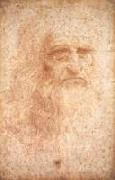 |
LEONARDO da Vinci
|
|
Italian High Renaissance Painter and Inventor, 1452-1519
Italian High Renaissance Painter and Inventor, 1452-1519 Florentine Renaissance man, genius, artist in all media, architect, military engineer. Possibly the most brilliantly creative man in European history, he advertised himself, first of all, as a military engineer. In a famous letter dated about 1481 to Ludovico Sforza, of which a copy survives in the Codice Atlantico in Milan, Leonardo asks for employment in that capacity. He had plans for bridges, very light and strong, and plans for destroying those of the enemy. He knew how to cut off water to besieged fortifications, and how to construct bridges, mantlets, scaling ladders, and other instruments. He designed cannon, very convenient and easy of transport, designed to fire small stones, almost in the manner of hail??grape- or case-shot (see ammunition, artillery). He offered cannon of very beautiful and useful shapes, quite different from those in common use and, where it is not possible to employ cannon ?? catapults, mangonels and trabocchi and other engines of wonderful efficacy not in general use. And he said he made armoured cars, safe and unassailable, which will enter the serried ranks of the enemy with their artillery ?? and behind them the infantry will be able to follow quite unharmed, and without any opposition. He also offered to design ships which can resist the fire of all the heaviest cannon, and powder and smoke. The large number of surviving drawings and notes on military art show that Leonardo claims were not without foundation, although most date from after the Sforza letter. Most of the drawings, including giant crossbows (see bows), appear to be improvements on existing machines rather than new inventions. One exception is the drawing of a tank dating from 1485-8 now in the British Museum??a flattened cone, propelled from inside by crankshafts, firing guns. Another design in the British Museum, for a machine with scythes revolving in the horizontal plane, dismembering bodies as it goes, is gruesomely fanciful. Most of the other drawings are in the Codice Atlantico in Milan but some are in the Royal Libraries at Windsor and Turin, in Venice, or the Louvre and the École des Beaux Arts in Paris. Two ingenious machines for continuously firing arrows, machine-gun style, powered by a treadmill are shown in the Codice Atlantico. A number of other sketches of bridges, water pumps, and canals could be for military or civil purposes: dual use technology. Leonardo lived at a time when the first artillery fortifications were appearing and the Codice Atlantico contains sketches of ingenious fortifications combining bastions, round towers, and truncated cones. Models constructed from the drawings and photographed in Calvi works reveal forts which would have looked strikingly modern in the 19th century, and might even feature in science fiction films today. On 18 August 1502 Cesare Borgia appointed Leonardo as his Military Engineer General, although no known building by Leonardo exists. Leonardo was also fascinated by flight. Thirteen pages with drawings for man-powered aeroplanes survive and there is one design for a helicoidal helicopter. Leonardo later realized the inadequacy of the power a man could generate and turned his attention to aerofoils. Had his enormous abilities been concentrated on one thing, he might have invented the modern glider.
|
|
 |
Leonardo Coccorante
|
|
Italian, 1680-1750 , Active in Naples during the frist half of the 18th Century
Active in Naples during the frist half of the 18th Century .was an Italian painter who was born in Naples, Italy. He studied with Jan Frans van Bloemen (1662-1749), Angelo Maria Costa (1670-1721), and finally with Gabriele Ricciardelli (active between 1741 and 1777). From 1737 to 1739, he was employed decorating the royal palace of Naples. Coccorante died in Naples in 1750. He is best known for his large highly detailed landscapes with imaginary classical architectural ruins. He often included small figures in the foreground to emphasize the expansiveness of the ruins. Coccorante is classified as a veduta (or vista) painter. The Honolulu Academy of Arts, the Louvre, the Lowe Art Museum (Coral Gables, Florida.), Mus??e d??partemental de l'Oise (Beauvais, France), Mus??e de Grenoble (Grenoble, France), Museo Regionale Agostino Pepoli (Trapani, Italy), and Pinacoteca del Castello Sforzesco (Milan, Italy)
|
|
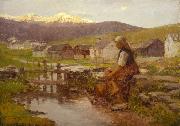 |
Leonardo Bazzaro
|
|
(Milan, 1853-1937) was an Italian painter.
After picking up the basics in the studio of the painter Gaetano Fasanotti, Bazzaro enrolled at the Brera Academy in Milan, where he was awarded the Fumagalli Prize in 1875. The following years saw a series of perspective views set in Milanese churches and mansions. The success achieved with the public and critics alike at a number of major national and international events prompted him to take an interest also in portraiture and landscape painting, for which his favourite settings were Venice and Chioggia. The works of the 1880s and 1890s also include increasingly intimist scenes of everyday life in the setting of Valsassina, Valle deAosta and Verbano. Bazzaro continued to take part in numerous exhibitions in the region of Lombardy as well as the Venice Biennale and the Rome Quadrenniale right up to his death, always achieving great success with collectors and being asked to execute replicas of his most popular subjects.
|
|
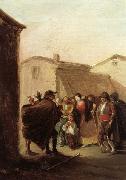 |
Leonardo Alenza Y Nieto
|
|
b Madrid, 6 Nov 1807; d Madrid, 30 June 1845
Spanish painter and illustrator. He studied at the Real Academia de S Fernando, Madrid, under Juan Antonio Ribera y Fern?ndez and Jos? de Madrazo y Agudo. He worked independently of court circles and achieved some fame but nevertheless died in such poverty that his burial was paid for by friends. He is often described as the last of the followers of Goya, in whose Caprichos and drawings he found inspiration for the genre scenes for which he became best known. Of these scenes of everyday life and customs the more interesting include The Beating (Madrid, Cas?n Buen Retiro) and Galician with Puppets (c. 1835; Madrid, Cas?n Buen Retiro; see SPAIN, fig. 17). Alenza y Nieto's numerous drawings include the illustrations for Alain-Ren? Lesage's Gil Blas (Madrid, 1840), for an edition of the poems of Francisco de Quevedo published by Castello and for the reviews Semanario pintoresco and El Reflejo. The painting Triumph of David
|
|
 |
Leonardo Da Vinci
|
|
Italian High Renaissance Painter and Inventor, 1452-1519
Florentine Renaissance man, genius, artist in all media, architect, military engineer. Possibly the most brilliantly creative man in European history, he advertised himself, first of all, as a military engineer. In a famous letter dated about 1481 to Ludovico Sforza, of which a copy survives in the Codice Atlantico in Milan, Leonardo asks for employment in that capacity. He had plans for bridges, very light and strong, and plans for destroying those of the enemy. He knew how to cut off water to besieged fortifications, and how to construct bridges, mantlets, scaling ladders, and other instruments. He designed cannon, very convenient and easy of transport, designed to fire small stones, almost in the manner of hail??grape- or case-shot (see ammunition, artillery). He offered cannon of very beautiful and useful shapes, quite different from those in common use and, where it is not possible to employ cannon ?? catapults, mangonels and trabocchi and other engines of wonderful efficacy not in general use. And he said he made armoured cars, safe and unassailable, which will enter the serried ranks of the enemy with their artillery ?? and behind them the infantry will be able to follow quite unharmed, and without any opposition. He also offered to design ships which can resist the fire of all the heaviest cannon, and powder and smoke.
The large number of surviving drawings and notes on military art show that Leonardo claims were not without foundation, although most date from after the Sforza letter. Most of the drawings, including giant crossbows (see bows), appear to be improvements on existing machines rather than new inventions. One exception is the drawing of a tank dating from 1485-8 now in the British Museum??a flattened cone, propelled from inside by crankshafts, firing guns. Another design in the British Museum, for a machine with scythes revolving in the horizontal plane, dismembering bodies as it goes, is gruesomely fanciful.
Most of the other drawings are in the Codice Atlantico in Milan but some are in the Royal Libraries at Windsor and Turin, in Venice, or the Louvre and the École des Beaux Arts in Paris. Two ingenious machines for continuously firing arrows, machine-gun style, powered by a treadmill are shown in the Codice Atlantico. A number of other sketches of bridges, water pumps, and canals could be for military or civil purposes: dual use technology.
Leonardo lived at a time when the first artillery fortifications were appearing and the Codice Atlantico contains sketches of ingenious fortifications combining bastions, round towers, and truncated cones. Models constructed from the drawings and photographed in Calvi works reveal forts which would have looked strikingly modern in the 19th century, and might even feature in science fiction films today. On 18 August 1502 Cesare Borgia appointed Leonardo as his Military Engineer General, although no known building by Leonardo exists.
Leonardo was also fascinated by flight. Thirteen pages with drawings for man-powered aeroplanes survive and there is one design for a helicoidal helicopter. Leonardo later realized the inadequacy of the power a man could generate and turned his attention to aerofoils. Had his enormous abilities been concentrated on one thing, he might have invented the modern glider.
|
|
|
|
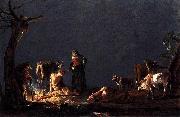 |
Leonaert Bramer
|
|
(24 December 1596 - 10 February 1674 (buried)) was a Dutch painter, best known for probably being one of the teachers of Johannes Vermeer, although there is no similarity between their work. Bramer's dark and exotic style is unlike Vermeer's style. Bramer was primarily a genre and history painter, but also made some unique frescos, not very often found north of the Alps. Leonaert Bramer is one of the most intriguing personalities in seventeenth-century Dutch art. He was a talented and diligent draughtsman, evidently Roman Catholic and a lifelong bachelor.
Bramer was born in Delft. In 1614, at the age of 18, he left on a long trip eventually reaching Rome in 1616, via Atrecht, Amiens, Paris, Aix (February 1616), Marseille, Genoa, and Livorno. In Rome he was one of the founders of the Bentvueghels group of Northern artists. He lived with Wouter Crabeth and got into a fight with Claude Lorraine. He dedicated a poem to Wybrand de Geest. Bramer remained on and off in Rome until October 1627, visiting Mantua and Venice, often for deliveries and to meet Domenico Fetti. In Italy Bramer was nicknamed Leonardo della Notte ("Leonardo of the night"). In 1648 he went to Rome for a second time.
By 1628 he was back in Delft, where he joined the Guild of Saint Luke in 1629 and the schutterij. Among his many patrons were members of the House of Orange, but local burgomasters and schepen also bought his paintings in great numbers.[3] He was a many sided artist, designing for tapestry firms in Delft, painting murals and ceilings, some of which are illusionistic in style. He painted real frescos in the Civic Guard house, the nearby stadholder's palaces in Honselersdijk, Rijswijk, the Communal Land Housde and the Prinsenhof in Delft.[3] Due to the Dutch climate they no longer survive.
He evidently knew the greatest of his Delft contemporaries, Johannes Vermeer, as he came to the latter's defence when his future mother-in-law was trying to prevent him from marrying her daughter.
|
|
|
|
|
|
 |
Leon Spilliaert
|
|
Belgian 1881-1946
Leon Spilliaert (1881 ?C 1946) was a Belgian symbolist painter and graphic artist.
Spilliaert was born in Ostend and from childhood displayed an interest in art and drawing. A prolific doodler and autodidact, he was predominantly a self taught artist. Sickly and reclusive, he spent most of his youth sketching scenes of ordinary life and the Belgian countryside. When he was 21 he went to work in Brussels for Edmond Demon, a publisher of the works of symbolist writers, which Spilliaert was to illustrate. He especially admired the work of Edgar Allan Poe.
Watercolor, gouache, and charcoal were the means by which he produced much of his best work, including a number of self-portraits executed in black crayon in the early years of the twentieth century. A significant influence on Spilliaert was Odilon Redon, whose expressive use of black finds parallels in his own work. Frequently depicting a lone figure in a dreamlike space, Spilliaert's paintings convey a sense of melancholy and silence.
His later work shows a concentration on seascapes. He died in 1946 in Brussels.
|
|
 |
Leon Lhermitte
|
|
1844-1925 was a French painter and etcher of the late nineteenth century. A student of Lecocq de Boisbourdran, he was a realist artist whose primary subject matter was of rural scenes depicting the peasant worker. He gained recognition after his show in the Paris Salon in 1864. His many awards include the French Legion of Honour (1884) and the Grand Prize at the Exposition Universelle in 1889. Lhermittees innovative use of the then contemporary media of pastels won him the admiration of his contemporaries. Vincent Van Gogh wrote that. If every month Le Monde Illustre published one of his compositions.
|
|
 |
Leon Kaplinski
|
|
(1824-1873) was a Polish painter and political activist.
Born 1824 in Lisew not far from Warsaw, Leon was the son of a small landowner and an eminent freemason Jan Kaplieski. The Kaplieskis were a Frankist family; his grandfather Eliasz Adam Kaplieski was one of the last known Frankists. Leon Kaplieski studied law and philosophy in Warsaw and Wrocław (Breslau). He was engaged in revolutionary underground groups, fled from the part of Poland under Russian rule, was briefly held and interrogated by the Prussian police, and took part in the revolutionary movement in 1848. In the same year Kaplieski emigrated to Paris where he spent most of his remaining years. He took part in Polish emigre political activities, closely connected with the circle of Hotel Lambert and the Czartoryski family, accompanied the Count Witold Czartoryski during his trip to the Balkans and the Near East. Kaplieski also edited the periodical Ephemerides Polonaises. He was married to Helena Hryniewiecka. In 1871 he moved back to Poland, living mostly in Krakew, and died in 1873 in Milosław. He befriended several well-known Polish artists and writers, including Henryk Rodakowski, Jan Matejka, and Cyprian Kamil Norwid.
Kaplieski studied art in Poland and later in Paris. His first known works are copies of paintings by famous Italian artists; later he became known and appreciated for his patriotic historical paintings as Wernyhora (1855). His best works are portraits: of his mother Julia (1860), the writer Bohdan Zaleski (1857), Count Adam Jerzy Czartoryski (about 1860), and an autoportrait as a Templar (about 1872). Many of his paintings and other works have perished or been lost. Mainly influenced by classical Italian art and his contemporary Rodakowski, L.K. continued the tradition of academic painting and had no interest for the emerging modernist tendencies of the mid-nineteenth century. He won some recognition in France, participating in the Paris art salons. L.K. wrote some poems and a short novel Nad Wisłą (On Wisla).
|
|
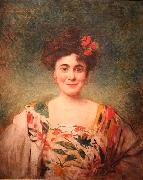 |
Leon Joseph Florentin Bonnat
|
|
(20 June 1833 - 8 September 1922) was a French painter.
He was born in Bayonne, but from 1846 to 1853 he lived in Madrid, where his father owned a bookshop. While tending his father's shop, he copied engravings of works by the Old Masters, developing a passion for drawing. In Madrid he received his artistic training under Madrazo. He later worked in Paris, where he became known as a leading portraitist, never without a commission. His many portraits show the influence of Velezquez, Jusepe de Ribera and other Spanish masters, as well as Titian and Van Dyke, whose works he studied in the Prado. Following the period in Spain Bonnat worked the ateliers of the history painters Paul Delaroche and Leon Cogniet (1854) in Paris. Despite repeated attempts, he failed to win the prix de Rome, finally receiving only a second prize. However, a scholarship from his native Bayonne allowed him to spend three years in Rome (1858 - 60) independently. During his stay in Rome, he became friends with Edgar Degas, Gustave Moreau, Jean-Jacques Henner and the sculptor Henri Chapu.
He won a medal of honor in Paris in 1869, going on to become one of the leading artists of his day. Bonnat went on to win the Grand Officer of the Legion d'honneur and became a professor at the Ecole des Beaux Arts in 1882. Bonnat was quite popular with American students in Paris. In addition to his native French, he spoke Spanish and Italian and knew English well, to the relief of many monolingual Americans. In May 1905 he succeeded Paul Dubois as director of the Ecole des Beaux-Arts. Bonnat "was a liberal teacher who stressed simplicity in art above high academic finish, as well as overall effect rather than detail," explains Julius Kaplan (see References). Bonnat's emphasis on overall effect on the one hand, and rigorous drawing on the other, put him in a middle position with respect to the Impressionists and academic painters like his friend Jean-Leon Gerôme.
|
|
|
|
 |
Leon Comerre
|
|
Leon François Comerre French. 1850 - 1934
|
|
 |
Leon Cogniet
|
|
French Academic Painter, 1794-1880,was a French painter. Cogniet was born in Paris. In 1812, he entered the Ecole des Beaux-Arts in Paris, where he studied under Pierre-Narcisse Guerin at the same time as Delacroix and Gericault. He was a resident at the Villa Medici, in Rome, from 1817 to 1822. A romantic painter, his main subjects were history and portraits, and in 1817 he won the Prix de Rome. He died in Paris in 1880.
|
|
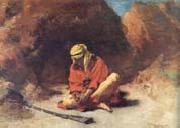 |
Leon Bonnat
|
|
French Academic Painter, 1833-1922,was a French painter. He was born in Bayonne, but from 1846 to 1853 he lived in Madrid, Spain, where his father owned a bookshop. In Madrid he received his artistic training under Madrazo. He later worked in Paris, where he became known as a leading portraitist. His many portraits show the influence of Velazquez and the Spanish realists. He won a medal of honor at Paris in 1869, where he became one of the leading artists of his day. Bonnat went on to become a professor at the Ecole des Beaux Arts in 1882. In May 1905 he succeeded Paul Dubois as director. His vivid portrait-painting is his most characteristic work, but his subject pictures, such as the Martyrdom of St Denis in the Pantheon, are also famous. Some of Bonnat's more notable students include: Gustave Caillebotte, Suzor-Cote, Georges Braque,Raoul Dufy, Marius Vasselon, Fred Barnard,
|
|
 |
Leon Benouville
|
|
Paris 1821 - Paris 1859.
was a French painter. Leon Benouville first studied with his elder brother Jean-Achille Benouville (1815-1891) in the studio of François-Edouard Picot before he transferred to Ecole des Beaux-Arts in 1837. Like his brother he received the Prix de Rome in 1845. In Rome, as a Prix de Rome pensionary at the Villa Medici, he stayed with his brother and met the sculptor Charles Gumery.
|
|
|
|
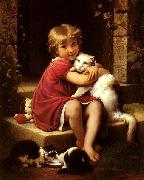 |
Leon Bazille Perrault
|
|
(20 June 1832, Poitiers - 1908, Royan) was a French painter.
A student of William Bouguereau and François-Edouard Picot, he exhibited at the Salon from 1863 onwards, producing several works, in the academic tradition. He was famous for his le petit naufrag (The little shipwrecked boy, 1874) and his paintings of children.
|
|
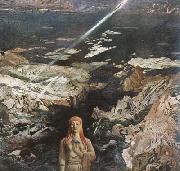 |
Leon Bakst
|
|
Russian Art Deco Designer and Illustrator, 1866-1924
|
|
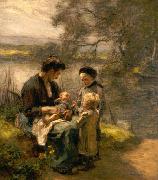 |
Leon Augustin Lhermitte
|
|
(1844 - 1925) was a French realist painter and etcher whose primary subject matter was of rural scenes depicting the peasant worker.
He was born in Mont-Saint-Pere. A student of Lecoq de Boisbaudran, he gained recognition after his show in the Paris Salon in 1864.
His many awards include the French Legion of Honour (1884) and the Grand Prize at the Exposition Universelle in 1889. Lhermitte died in Paris in 1925.
Lhermittees innovative use of pastels won him the admiration of his contemporaries. Vincent Van Gogh wrote that eIf every month Le Monde Illustre published one of his compositions ... it would be a great pleasure for me to be able to follow it. It is certain that for years I have not seen anything as beautiful as this scene by Lhermitte ... I am too preoccupied by Lhermitte this evening to be able to talk of other things.e
Lhermitte's etchings and paintings are housed in museums around the world including Boston, Washington, Chicago, Montreal, Brussels, Rheims, Paris, Moscow and Florence.
|
|
|
|
|
|
|
|
|
| Wholesale China Oil Painting Wholesale Oil Painting China Xiamen Portrait Reproduction on canvas Chinese Oil Painting Wholesale USA Oil Painting |
|
|
|
|
|